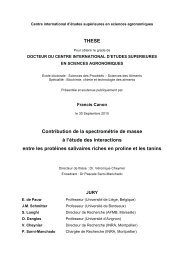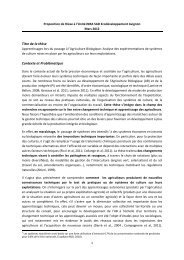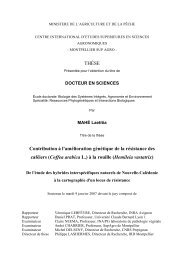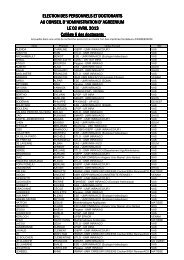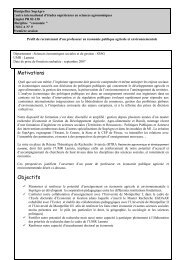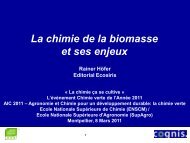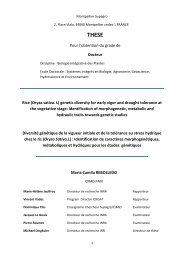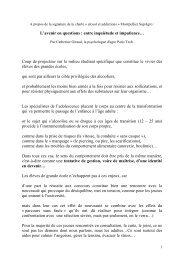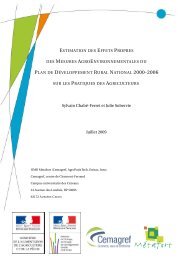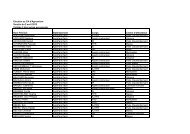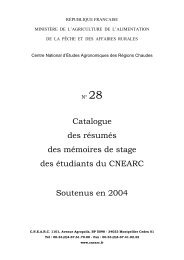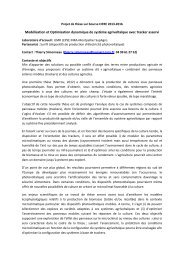Conversion to Organic Farming: A Typical Example of the Diffusion ...
Conversion to Organic Farming: A Typical Example of the Diffusion ...
Conversion to Organic Farming: A Typical Example of the Diffusion ...
Create successful ePaper yourself
Turn your PDF publications into a flip-book with our unique Google optimized e-Paper software.
<strong>Conversion</strong> <strong>to</strong> <strong>Organic</strong> <strong>Farming</strong>57ogy transfer extension approach that is frequently associated with adoption researchhas <strong>to</strong> be rejected. Instead a broad vision <strong>of</strong> a knowledge network with <strong>the</strong> involvemen<strong>to</strong>f producers, advisors and researchers should be aimed for.However, this does not imply that <strong>the</strong> adoption model itself cannot be used <strong>to</strong>provide some recommendations for <strong>the</strong> future development <strong>of</strong> support services <strong>of</strong>organic farming. On <strong>the</strong> basis <strong>of</strong> <strong>the</strong> review <strong>the</strong> following are presented as a basisfor fur<strong>the</strong>r debate.Promotion should be based on <strong>the</strong> advantages <strong>of</strong> <strong>the</strong> organic system and on newmanagement approaches ra<strong>the</strong>r than criticism <strong>of</strong> conventional agriculture, whichwould help <strong>to</strong> minimize <strong>the</strong> negative reactions amongst conventional farmers.The sec<strong>to</strong>r bodies involved in standard setting and certification should allow onfarmexperimentation with organic farming for converting producers (for exampleby allowing partial certification <strong>of</strong> specified units within a whole farm) as this is animportant step in <strong>the</strong> farmers’ decision-making process. It should be explored fur<strong>the</strong>rwhe<strong>the</strong>r conversion planning could support or even replace this process. Morewidespread conversion planning could also help <strong>to</strong> reduce <strong>the</strong> risk that is associatedwith a conversion.According <strong>to</strong> <strong>the</strong> model, farmers in <strong>the</strong> same category <strong>of</strong> adopters share similarvalues and characteristics and are <strong>the</strong>refore likely <strong>to</strong> be interested in <strong>the</strong> adoption<strong>of</strong> a particular innovation at <strong>the</strong> same time. For innovations that improve pr<strong>of</strong>its,Early adopters are likely <strong>to</strong> value pr<strong>of</strong>it making highly, whereas for environmentalinnovations <strong>the</strong>y might share o<strong>the</strong>r values. The organic farming system may bestbe placed in <strong>the</strong> middle ground, as it includes broader environmental as well asfinancial goals and indeed farmers appear <strong>to</strong> be converting <strong>to</strong> organic productionfor a range <strong>of</strong> motives, reflecting its broad range <strong>of</strong> aims.Advisors and o<strong>the</strong>rs involved in organic farming organizations and sec<strong>to</strong>r bodiesneed <strong>to</strong> recognize that a shift in motives, farm and social characteristics amongthose converting <strong>to</strong> organic farming is a typical feature <strong>of</strong> any diffusion process,and not an inherent shortcoming <strong>of</strong> those currently converting. As <strong>the</strong> diffusionprocess <strong>of</strong> this in some ways untypical innovation has shown <strong>the</strong> innova<strong>to</strong>rs teach<strong>the</strong>mselves and learn with <strong>the</strong> support <strong>of</strong> o<strong>the</strong>r innova<strong>to</strong>rs or through direct access<strong>to</strong> primary information sources. Those that convert at a later stage are more likely<strong>to</strong> make more use <strong>of</strong> advice. For <strong>the</strong>m <strong>the</strong> fur<strong>the</strong>r adoption/diffusion process <strong>of</strong>organic farming as a knowledge-based innovation may depend critically on <strong>the</strong>wide availability <strong>of</strong> credible information, about <strong>the</strong> principles as well as <strong>the</strong> likelyfinancial implications, although more research is needed <strong>to</strong> better understand <strong>the</strong>irinformation requirements. It is <strong>the</strong> challenge for advisors and <strong>the</strong> organic farmingsec<strong>to</strong>r <strong>to</strong> develop strategies how <strong>the</strong>y can be met so that those farmers convertingat a later time in <strong>the</strong> diffusion process can receive information and advice that istargeted <strong>to</strong> <strong>the</strong>ir particular needs.ReferencesAlbrecht, H. (1974) Die Verbreitung von Neuerungen – der <strong>Diffusion</strong>sprozess. Der Förderungsdienst22 (2) pp. 33–40Albrecht, H. (1980) <strong>Diffusion</strong> processes and social structure: Review <strong>of</strong> research within rurualsociology. Pp. 39–51 in H.J. Hummel and W. Sodeur eds, Modelle für Ausbreitungsprozessein sozialen Strukturen (Bad Homberg: Verlag der Sozialwissenschaftlichen Kooperative)



